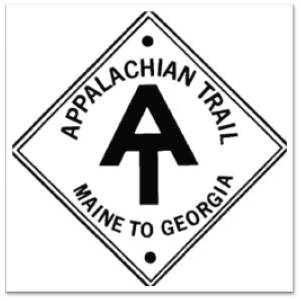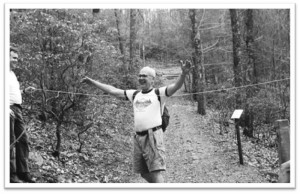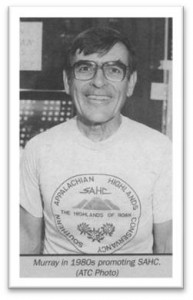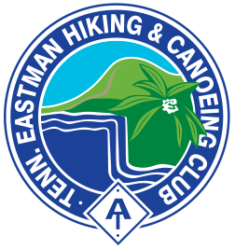Our Beginnings
The AT had been originally envisioned by Benton MacKaye as a trail connecting Mount Washington in New Hampshire with Mount Mitchell and the Black Mountains. In the 1920’s Paul Fink, from Jonesborough, was invited to a meeting of the fledgling Appalachian Trail Conference through an association with the president of the Appalachian Mountain Club. Mr. Fink told the president, “You are missing the best if you go to Mitchell only. The best route is along the state line.” Thus the route through the Smokies was proposed. Paul Fink went on to play a major role in the entire southern routing of the AT with a 1922 map of the southern end of the Trail, helped found the Smoky Mountain Hiking Club, and was the last surviving founder of ATC.
 In 1945 Frank Oglesby convinced the Tennessee Eastman Recreation Club that a club geared towards outdoor recreation would be valuable for Tennessee Eastman employees. The first hike was held on April 28, 1946 to Buckeye Falls, on Clark Creek in Unicoi County. What would become known as the TERC Hiking Club sponsored numerous hikes and social activities, with many single members, in those early years. Perhaps this social component was behind the following statement, in part of a description of the Club by the 1953 Steering Committee.
In 1945 Frank Oglesby convinced the Tennessee Eastman Recreation Club that a club geared towards outdoor recreation would be valuable for Tennessee Eastman employees. The first hike was held on April 28, 1946 to Buckeye Falls, on Clark Creek in Unicoi County. What would become known as the TERC Hiking Club sponsored numerous hikes and social activities, with many single members, in those early years. Perhaps this social component was behind the following statement, in part of a description of the Club by the 1953 Steering Committee.
“It is customary to elect at least one girl to the steering committee every year. The advantages of this should be obvious.”
By this time the Appalachian Trail had already been established in Tennessee and throughout its route. However, the route was very different than it is today, or even than it was 40 years ago. Most of the AT from the Nolichucky River to Damascus followed roads, not only forestry roads in the mountains but also automobile roads between Limestone Cove and Winner community in Stoney Creek valley. The only current long section of the AT which was part of the original Trail route is the northernmost 18 miles, from the junction of Cross and Holston Mountains to near Damascus. It would be two more years (1948) before Earl Shaffer would become the first person to hike the entire AT, at the time 1400 miles long, in one continuous journey.
In 1946, the AT on what is now our section was maintained by three different organizations. The Roan Hiking Club, based in Greeneville, was responsible for the section between Damascus and Winner, and from Limestone Cove to the Nolichucky River. Paul Fink was responsible for marking the 28 miles of road walk between Winner and Limestone Cove. The northernmost section of the Carolina Mountain Club was between the Nolichucky River at Unaka Springs and Spivey Gap, a little over six miles. This was a considerable distance from Asheville and CMC had some difficulty finding enough people to maintain their section.
On November 11, 1946, delegates from TEHC met with ATC Board Chair Myron Avery at a “Class D membership meeting” in Knoxville. At that meeting, the groundwork was laid for us to take over maintenance of a section of the AT. Our first work trip was in May of that year, and on July 12, 1947, members joined CMC for a scouting trip of the Spivey-Nolichucky section. On August 13, 1947, we were invited to take over this section, and TEHC is shown on a September 1947 ATC list of Trail-maintaining organizations. Our linkage with other AT-maintaining clubs grew when Frank Oglesby proposed the first southern Multi-Club meet, attended by representatives from CMC, SMHC, GATC, and TEHC in August 1947.
It did not take long for our maintenance responsibility to grow, significantly. In October 1947 we reached agreement with the Roan Hiking Club to take over both their sections, increasing our responsibility to over 57 miles. In a December 1947 letter from Myron Avery to Frank Oglesby documenting this assignment, Mr. Avery stated that the northern end of our section is at the “Virginia-Tennessee line (Damascus)”. That discrepancy has caused considerable confusion and occasional consternation through the years. It was set on Reynolds Street in Damascus until 2013 when it was changed to the VA/TN state line by agreement. Later, in 1948, Frank Oglesby became the first TEHC member to join the ATC Board of Managers, replacing Paul Fink.
The 54-Mile Relocation
From the early days, there was a desire to move the AT off of roads to a more primitive setting in the woods. For no section was there a stronger desire to do so than the road walk between Limestone Cove and Winner. In addition to the long road walk, another problem was the increasing number of electronic facilities atop Holston Mountain. During construction of an omnirange radar system, the FAA cleared five acres for the site and obliterated the Trail. However, the bigger driving force was the opportunity for improvement. A vision of a major reroute to take the AT on up the state line, across the Roan Highlands, down White Rocks Mountain, through Laurel Fork Gorge, and on up Iron and Cross Mountains to reconnect at Holston Mountain took hold.
Some of our old documents credit the idea for what we sometimes call “the 54-mile relocation” to Frank Oglesby. Others credit a newer member, Stan Murray. Stan, a native of Maine, began hiking in the Smokies when stationed in Oak Ridge during World War II and came to Tennessee Eastman in 1949. In May 1952, Frank introduced Stan at the biennial ATC meeting where Stan proposed the relocation (Stan was our Steering Committee Chair at the time). The relocation was approved at the meeting. That was all the approval necessary!
Not everyone agreed that the 54-mile relocation was a good thing. In a 1952 photo Stan is shown pointing out the proposed route of the relo to Club members Ed Gill and Ray Hunt. Ray, like many other Club members through the years, was recruited by Stan, and his first work trip was on this relocation. Ray later wrote of telling Stan that “he didn’t know where we were going, what we were doing, or why”, that “he thought it was awful”, and that “he didn’t see the point of it and thought it would be the ruination of the Club”! In that same passage though, Ray said “I was wrong of course and am glad I was.”
 Relocations in those days consisted mainly of finding a route and blazing a path. There was no digging. Little consideration was given to the Trail going straight up and down knobs – it was steep in New England so it could be steep here too! A major difference though is instead of the bedrock granite of New England, there is soil in our mountains. Through the years erosion occurred, especially in the soft organic soils, high precipitation, and high use of the Roan Highlands. We continue to this day tinkering with the Trail route to improve over that initial massive project. One of Frank Oglesby’s many memorable comments was, “I’m now relocating my relocations!” But, in no manner should this take away from the vision and hard work those pioneers put forth. The result is Trail-wide recognition for having one of the most scenic sections of the entire AT.
Relocations in those days consisted mainly of finding a route and blazing a path. There was no digging. Little consideration was given to the Trail going straight up and down knobs – it was steep in New England so it could be steep here too! A major difference though is instead of the bedrock granite of New England, there is soil in our mountains. Through the years erosion occurred, especially in the soft organic soils, high precipitation, and high use of the Roan Highlands. We continue to this day tinkering with the Trail route to improve over that initial massive project. One of Frank Oglesby’s many memorable comments was, “I’m now relocating my relocations!” But, in no manner should this take away from the vision and hard work those pioneers put forth. The result is Trail-wide recognition for having one of the most scenic sections of the entire AT.
Early Maintenance Practices
When completed, the 54-mile relocation gave us a Trail section of over 110 miles, close to the current length. We had a lot of work to do! One of those tasks was to measure the length of the Trail. The club inherited a measuring wheel used by Myron Avery which was in our possession until 2013 when we donated it to the Appalachian Trail Museum located in Pine Grove Furnace State Park (Gardners, PA).
During this period, some of our current maintenance practices were developed, with Stan, Frank, Hugh Thompson and others among the leaders. Our section was apportioned into 13 maintenance teams to do the needed blazing and clearing. The teams moved four sections north each year, providing a change of scenery as well as providing an avenue to see our entire section over a 13-year period. Although much of our section is now “adopted” by individuals and teams having the same section each year, the opportunity to have a rotational assignment continues.
Other practices that originated during this period continue to this day. Collins Chew invented a “sponge bucket” that could deliver a perfect 2″ x 6″ blaze. In addition to his exemplary service in just about every capacity for TEHCC, Collins’ deep knowledge of geology led to his authorship of a popular book, Underfoot: A Geologic Guide to the Appalachian Trail which is referenced in Bill Bryson’s book A Walk in the Woods and the subsequent movie of same name starting Robert Redford and Nick Nolte. Creative use of tools for Trail maintenance has always been a TEHC hallmark. A lightweight but effective tool for cutting briars was known as “the Lively Lad”. Although some maintainers preferred heavier mowing scythes or weedeaters as they became popular, it was hard to match the Lively Lad for weight and efficiency. We began to recruit retirees for the Trail maintenance teams. Many of our stalwart maintainers of today and the recent past joined during this time.
Hiking popularity began to grow in the 1960’s. There was a desire to establish a continuous chain of Trail shelters, located no more than a day’s hike apart. Most of the shelters along our section were constructed by the Forest Service in the early 1960’s. The cinder block structures draw a few comments today, but they have stood up exceptionally well through the years, with periodic maintenance to the roofs, flooring, and a fresh coat of paint. In 1966 it was our turn to build one, again in Laurel Fork Gorge mostly out of native stone. This effort required hauling 800 pounds of cement, 2500 pounds of sand, and 200 pounds of hardware, along with several tons of rock, to the work site, requiring about 100 trips. We could have used student groups and thru-hikers in those days! A sad story is our Don Nehlen Shelter in Sugar Hollow, a beautiful shelter constructed of native logs in 1981 but was burned in 1989. It took nearly 20 years to find a good location for a replacement shelter, our newest at Mountaineer Falls.
National Leadership – Stan Murray and Ray Hunt
Management of the Appalachian Trail goes beyond the on the ground maintenance, and we can be proud of our contributions in those respects. Through the years we have had several ATC Board members, including Frank Oglesby, Collins Chew, Paul Worsham, and Steve Wilson. Two TEHC members have not only been on the Board but chaired it, both in outstanding fashion – Stan Murray and Ray Hunt.
 Stan, from Maine, had been an avid participant in both the Club’s recreational hike and maintenance efforts since joining Eastman in 1949. His role in the relocation across Roan Mountain and his dedication to the AT led to his election to the Board in 1955. Stan led the push for the string of shelters or campsites at regular intervals along the Trail. He was elected Board Chair in 1961 and served in that position until 1975; only Myron Avery chaired the ATC Board longer. In the spirit of Benton Mackaye’s vision for the AT, Stan pushed the greenway concept for true protection of not only the footpath itself, but the Trail environment. A quote from the last year of his life: “If the Appalachian Trail is to survive as a continuous footpath along the Appalachian mountains and if it is to offer a wilderness experience, then more than a narrow path winding through second-home developments, with background noises of chainsaws and barking dogs, a trail hidden in underbrush and trees away from panoramic scenery – more than this is needed.” This dedication to conservation helped lead to many things – passage of the National Trails System Act of 1968, blocking of a proposed road across the Smokies, efforts to protect the viewshed along the Trail, and the formation of the Southern Appalachian Highlands Conservancy to protect lands in the Roan Highlands and elsewhere. All the while Stan remained a Trail maintainer, not only establishing the first committee on Trail maintenance standards, but also stressing the importance of volunteers, championing the “free spirit of the individual worker, without whose continued care and stewardship the Trail might become something without a soul”.
Stan, from Maine, had been an avid participant in both the Club’s recreational hike and maintenance efforts since joining Eastman in 1949. His role in the relocation across Roan Mountain and his dedication to the AT led to his election to the Board in 1955. Stan led the push for the string of shelters or campsites at regular intervals along the Trail. He was elected Board Chair in 1961 and served in that position until 1975; only Myron Avery chaired the ATC Board longer. In the spirit of Benton Mackaye’s vision for the AT, Stan pushed the greenway concept for true protection of not only the footpath itself, but the Trail environment. A quote from the last year of his life: “If the Appalachian Trail is to survive as a continuous footpath along the Appalachian mountains and if it is to offer a wilderness experience, then more than a narrow path winding through second-home developments, with background noises of chainsaws and barking dogs, a trail hidden in underbrush and trees away from panoramic scenery – more than this is needed.” This dedication to conservation helped lead to many things – passage of the National Trails System Act of 1968, blocking of a proposed road across the Smokies, efforts to protect the viewshed along the Trail, and the formation of the Southern Appalachian Highlands Conservancy to protect lands in the Roan Highlands and elsewhere. All the while Stan remained a Trail maintainer, not only establishing the first committee on Trail maintenance standards, but also stressing the importance of volunteers, championing the “free spirit of the individual worker, without whose continued care and stewardship the Trail might become something without a soul”.
Ray followed not far behind Stan with active involvement in both TEHC and ATC. Ray was a strong advocate of publications and edited the local guidebook and created the first AT Data Book in 1977. He originated the AT Committee as a body of experienced TEHC members to oversee AT management, without the frequent turnover of our Steering Committee. Ray was elected to the ATC Board in 1979 and very soon thereafter, in 1983, was elected to the first of his three terms as Board Chair. In 1984 Ray signed the MOU delegating management responsibility for AT lands to ATC. Ray, with his typically wry wit, called this agreement “the most important document that I ever hope to sign”, but later added, “I had overlooked my marriage license”. Ray was a tireless champion for land acquisition to protect the AT, with the federal protection afforded to it with the National Trails System Act and helped to spearhead the Optimal Location Reviews. This approach led into the program of relocating the AT to improve the Trail experience – a job is almost complete for the club’s section.
Relocations and Today’s Maintenance
The Optimal Location Reviews (OLRs) identified the preferred route of the Trail, the land protection needed, and the relocations that would be required. An early example of use of this process was the Hump Mountain Relocation in the early 1980’s. The Trail climbing Hump from Highway 19E had followed Pink Winters Road through Mr. Winters’ yard, climbed steeply from there to Doll Flats, then climbed very steeply to the top of Hump. The reroute got the Trail off the road and into woods, climbing by the former Apple House Shelter initially alongside private land, then climbed Hump on a sidehill grade which was one of our first projects with the Konnarock Crew. In later years some of the steeper sections below Doll Flats were further relocated, in part to move away from the private land. There was an unforgettable sign along this part of the Trail for many years, “Beware of Shootgun”! Along with Ray, Ed Oliver, Darrol Nickels, Jeff Siirola, Jack Young and others were leaders in these OLR activities and developed prodigious trail routing and construction skills.
In the late 1980’s and early 1990’s, it became apparent that we needed to do more. With our long section – now the third longest on the AT – we regularly finished near the bottom of all clubs in hours of maintenance per mile of Trail. We received complaints. There was a small group of 6-10 people who were doing almost all of our work. Then, several things happened that turned this around. The first was our Trail adopter program. Ted Malone had the vision of reaching out to the community and finding people who might not want a rotating assignment, but might be willing to adopt a favorite or nearby section. This approach has led to about 90% of our Trail section being adopted. That enthusiasm also brought in several strong new maintainers from both inside and outside of Eastman. Another very enthusiastic maintenance coordinator followed Ted, Bill Stowell. Bill continued to reach out to the community and started the first contacts with student groups which continue today. Our annual hours spent on AT maintenance zoomed from less than 2000 hours to peak at 15,755 hours in 2014. The electronic records diligently kept by Jeff Siirola, from January 2000 through October 2018, totaled over 220,000 hours by 6,000 individual maintainers across 5,750 events! We are very fortunate to have another enthusiastic and highly organized maintenance coordinator today in Carl Fritz, who has led the club through the final leg of planned trail relocations to have a 133.8-mile section from the Tennessee-Virginia state line to U.S. Highway 19W near Spivey Gap.
 Another boon to our Club has been Bob Peoples. Bob brought Trail maintenance experience with the Green Mountain Club with him to Carter County, but much more, he brought a spirit of ambassadorship reminiscent of Stan and Ray. Bob regularly gets out hikers to help during through-hiker season, and especially with the former Damascus HardCore events which had gained notoriety throughout the Trail. Many of the hikers came back not just to give back to the Trail but to show their appreciation to Bob and his wife Pat.
Another boon to our Club has been Bob Peoples. Bob brought Trail maintenance experience with the Green Mountain Club with him to Carter County, but much more, he brought a spirit of ambassadorship reminiscent of Stan and Ray. Bob regularly gets out hikers to help during through-hiker season, and especially with the former Damascus HardCore events which had gained notoriety throughout the Trail. Many of the hikers came back not just to give back to the Trail but to show their appreciation to Bob and his wife Pat.
The club must thank the many volunteers who have shown such diligence through the years to keep our maintenance efforts going. Our challenge for the future is to keep this level of involvmentment high while bringing in new blood. We have a proud legacy.
— Last edited in October 2018.

